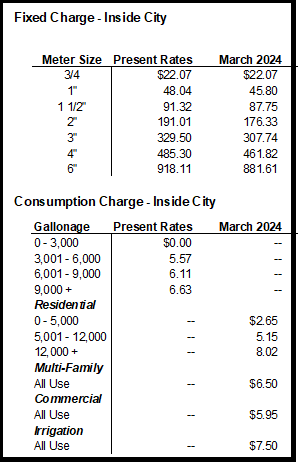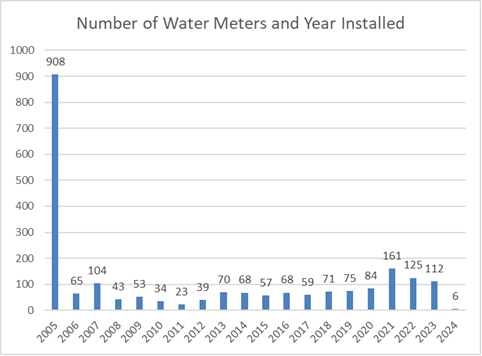Municipal Water: Rates, Meters and Pipes
The City has been experiencing a lot of water system activity over the last several weeks. In this article I will be discussing several aspects of the City’s water system, including the new water rate structure approved by the City Council, replacing the water meter reading system and addressing the need to replace aging water transmission pipes.
The sole source of the City’s water supply is water purchased wholesale from the Medford Water Commission and delivered to Talent through large transmission pipes that also serve Phoenix and Ashland.
The City’s water utility is operated as an “enterprise” meaning that, essentially, it is a non-profit business owned and operated by the City. As an enterprise, the water utility is funded through user fees paid by water customers, and not subsidized by tax revenue. Periodically, the City may utilize grant funding to support a capital improvement that has a general benefit to the community, or to keep rates lower. This is the way that the great majority of city-owned utilities are operated.
A number of issues have converged that are requiring the City Council to make some challenging decisions…decisions that ultimately impact Talent residents and businesses in the form of higher water bills. Major factors impacting the financial condition of the water utility include:
Increases in the cost of purchased water from the Medford Water Commission.
Costs of supplies and materials increasing at a rate faster than the rate of inflation.
Increasing the rate of existing debt repayment to avoid upcoming large ballon payments that were a part of an earlier debt restructuring. The City’s water related debt is currently $4.3 million.
Increasing employee-related costs, with some items such as insurance rising at a rate higher than inflation.
More frequent pipe failures and repairs as pipe material reaches its “end of life” after being in the ground for as much as five decades or more.
NEW RATES
The City Council retained the financial and engineering consulting firm, HDR, Inc, to conduct a comprehensive review of the City’s water rates, taking into consideration future operations costs, long-term debt and capital costs. HDR specializes in utility rate studies. They found, through a “cost of service study” that, beginning this year, revenue from water customers will be insufficient to cover the cost of operating the water system, paying for capital improvements needed to sustain the system and making debt payments.
The desired outcome of this study was to ensure that rates are sufficient to cover costs associated with ongoing maintenance and operations of the water utility, along with the cost of purchasing wholesale water from the Medford Water Commission, and capital projects needed to replace the aging system. Other goals included encouraging conservation while having all customers pay an equitable share of the cost of service. The study created a five-year plan for assuring that the water utility remains self-sustaining.
The City Council considered several options for a new rate structure presented by HDR, and settled on a modification of one of those options.
Change 1: Base Rate + Usage Charge
For a number of years, usage of up to 3,000 gallons per month was included in the monthly base residential base. In the new structure, customers will still pay a base rate, but will also pay for usage in the three-tier structure as described in the graphic below (This example is for a ¾ or 5/8 meter serving a single-family residence with a usage of 6,000 gallons per month). In other words, water used is no longer included in the base rate and customers will also pay a “consumption charge” with increasing usage rates.
GRAPH 1

GRAPH 2

A water rate schedule for all meter sizes and uses can be found on the City’s website.
Change 2: Establishing a Fee for Capital Improvements
The City Council also removed from the monthly user rate “cost of service calculation” the estimated amount of funding that will be needed to undertake a capital improvement program over a five-year period.
The new rate structure establishes a monthly “Water System Replacement Fee” that will be collected from each customer and deposited into a fund that will be used to replace the City’s aging water distribution system. By adoption of City Council Resolution 2024-086-R, the proceeds of this fee may only be used for water system construction, primarily replacement of worn-out pipe, pumping components and reservoirs, and cannot be used for any other purpose…such as employee salaries. The funds also cannot be shifted to fund general City operations. The fee amount varies by water meter size.
The rate study proposed a five-year rate adjustment plan as shown in the following graph. The actual rate adjustment will be considered by the City Council annually.
GRAPH 3

GRAPH 4

WATER METERS
The water meters used to gather information on water usage vary in age. As meters age, they typically read slower as internal components wear-out. Some years ago, the City converted its method of reading meters from having a City employee manually read each meter and recording the information in a tablet, to a system where the meter reader uses a hand-held device to “read” the meter through an electronic signal. This was a significant improvement in efficiency at the time. The hardware and software necessary to support this data collection is wearing out and is no longer supported by the manufacturer…meaning that the devices and software cannot be repaired or upgraded. Just last month the meter-reading device failed, and City employees had to manually record data from hundreds of accounts, and manually enter that data into the billing system…more than doubling the amount of time required to perform this function.
GRAPH 5

Now, there has been another advancement in meter reading technology. The City recently issued a Request for Proposals to provide an entirely new metering and remote meter reading system. The goal is to replace all of the meters currently in operation with meters that are equipped with an electronic device that can allow a City employee to read the meter from the City Hall office, and that would be programmed to perform automatic reading on the same day each month and transmit that data to the City Hall office electronically…without having a City employee visit every meter location. Depending upon the technology chosen and cost, this real-time system could also alert City staff…who would then alert the customer…of potential leaks. The meters could also be turned on and off from the office, saving time and money now spent when there is a customer change. The system may also enable customers to monitor their own usage online.
THOSE LEAKY PIPES
Since I’ve been with the City (about two months) it seems like our Public Works crew responds to at least one broken water main pipe each week. Asbestos/Cement (A/C) water pipe…made of a mixture of asbestos fibers and concrete to make the pipe more structurally sound…became the most popular pipe for use in water systems in the 1950’s. A/C pipe was designed to last around 70 years, and we have entered that “end of useful life” period. The pipe gets more brittle with age, and it is more difficult to handle when employees work on repairing the pipe because…as we now know…those asbestos fibers encased in the cement material are a hazardous material when the pipe is broken or cut. When the pipe does fail, it often results in a catastrophic collapse of the pipe with no warning. According to the American Water Works Association, the number of A/C pipe failures reported across the nation has increased dramatically in recent years.
About 30 per cent of the pipe in the Talent system is A/C. This pipe is under constant pressure from both internal water pressure and external forces. Our consulting engineer has estimated it will cost about $2.3 million to replace all of the A/C pipe in the Talent water system.
Replacement of the A/C pipe over a period of years was included in the cost analysis portion of the water rate study. We are also looking for state/federal grant funding to help pay for the cost of replacing the pipe in our system. Most recently, the City submitted a request for $2.0 million through the 2025 Community Initiated Project Appropriations program. If approved, this will have an impact circling back to the first part of this article…the water rates. If we are able to secure grant funding to help pay for a portion of the water pipe replacement or refinance the City’s current water system related indebtedness of about $4.3 million, future water rate increases will likely be lower.
The condition of the water pipelines beneath our streets is not only a concern to drinking water customers, but is a public safety concern. Use of high volumes of water for firefighting puts additional stress on these pipes, and pipe failures could have a devastating impact on the availability of water for firefighting.
Gary Milliman
City Manager
City of Talent
Documents:
Press Release - Water Rates
Press Release - Water Rates (summary)

